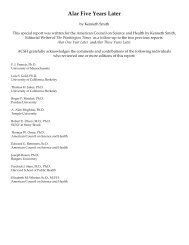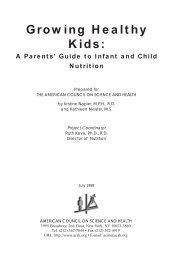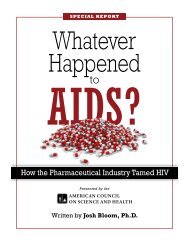The Role of Beef in the American Diet - International Meat Secretariat
The Role of Beef in the American Diet - International Meat Secretariat
The Role of Beef in the American Diet - International Meat Secretariat
Create successful ePaper yourself
Turn your PDF publications into a flip-book with our unique Google optimized e-Paper software.
<strong>The</strong> <strong>Role</strong> <strong>of</strong> <strong>Beef</strong> <strong>in</strong> <strong>the</strong> <strong>American</strong> <strong>Diet</strong><br />
12<br />
with a variety <strong>of</strong> potentially beneficial effects, <strong>in</strong>clud<strong>in</strong>g <strong>in</strong>hibition <strong>of</strong><br />
mammary carc<strong>in</strong>ogenesis (12), <strong>in</strong>hibition <strong>of</strong> mutagenesis (13), <strong>in</strong>creased<br />
muscle mass and decreased body fat (14), <strong>in</strong>hibition <strong>of</strong> <strong>the</strong> development<br />
<strong>of</strong> a<strong>the</strong>rosclerosis (15,16), and <strong>in</strong>creased bone density (17). It rema<strong>in</strong>s to<br />
be clearly demonstrated whe<strong>the</strong>r CLAs have <strong>the</strong>se same beneficial<br />
effects <strong>in</strong> humans.<br />
IV. <strong>Beef</strong> <strong>in</strong> <strong>the</strong> Heart-Healthy <strong>Diet</strong><br />
<strong>The</strong> federal government’s <strong>Diet</strong>ary Guidel<strong>in</strong>es for <strong>American</strong>s and <strong>the</strong><br />
dietary guidel<strong>in</strong>es published by <strong>the</strong> <strong>American</strong> Heart Association (AHA)<br />
advise all healthy <strong>American</strong>s (except those under <strong>the</strong> age <strong>of</strong> two years)<br />
to limit <strong>the</strong>ir <strong>in</strong>takes <strong>of</strong> saturated fat and cholesterol to reduce <strong>the</strong> risk <strong>of</strong><br />
a<strong>the</strong>rosclerosis and its consequences, <strong>in</strong>clud<strong>in</strong>g coronary heart disease<br />
(8,18,19). * People <strong>of</strong>ten <strong>in</strong>terpret this recommendation to mean that <strong>the</strong>y<br />
should elim<strong>in</strong>ate red meat from <strong>the</strong>ir diets — or at least severely restrict<br />
it — and eat poultry or fish <strong>in</strong>stead. In a survey conducted for a food<br />
<strong>in</strong>dustry trade group <strong>in</strong> 2000, 22% <strong>of</strong> consumers reported that <strong>the</strong>y were<br />
eat<strong>in</strong>g less red meat and 9% reported that <strong>the</strong>y were eat<strong>in</strong>g more poultry<br />
<strong>in</strong> an effort to make <strong>the</strong>ir diets healthier (20). However, dietary changes<br />
<strong>of</strong> this type may not be necessary — or even desirable.<br />
Current <strong>Diet</strong>ary Recommendations<br />
Contrary to what many people th<strong>in</strong>k, <strong>the</strong> federal and AHA dietary<br />
recommendations do not call for <strong>the</strong> replacement <strong>of</strong> red meat with poultry<br />
and fish. Instead, <strong>the</strong>y call for:<br />
1. Limit<strong>in</strong>g <strong>in</strong>take <strong>of</strong> meat, poultry, and fish to moderate amounts. <strong>The</strong><br />
recommended <strong>in</strong>take <strong>of</strong> <strong>the</strong>se foods is approximately two threeounce<br />
serv<strong>in</strong>gs per day. A three-ounce serv<strong>in</strong>g is about <strong>the</strong> size <strong>of</strong> a<br />
deck <strong>of</strong> cards.<br />
2. Cook<strong>in</strong>g without added fat. Broil<strong>in</strong>g, boil<strong>in</strong>g, and roast<strong>in</strong>g are<br />
preferable to fry<strong>in</strong>g.<br />
3. Remov<strong>in</strong>g easily separated fat. This means trimm<strong>in</strong>g all visible fat<br />
<strong>of</strong>f red meat and remov<strong>in</strong>g poultry sk<strong>in</strong> and <strong>the</strong> visible fat under <strong>the</strong><br />
sk<strong>in</strong>.<br />
* In September 2002, <strong>the</strong> National Academy <strong>of</strong> Sciences (NAS) committee that establishes<br />
dietary reference <strong>in</strong>takes for <strong>the</strong> U.S. released a new report that made no quantitative<br />
recommendations on saturated fat and cholesterol <strong>in</strong>take but <strong>in</strong>stead called for<br />
keep<strong>in</strong>g consumption <strong>of</strong> <strong>the</strong>se two food components as low as possible while ma<strong>in</strong>ta<strong>in</strong><strong>in</strong>g<br />
a nutritionally adequate diet. <strong>The</strong> report also stated that total fat should account for<br />
between 20 and 35% <strong>of</strong> total calories; this is a change from previous advice that it<br />
should not exceed 30%. <strong>The</strong> new NAS recommendations have not yet been <strong>in</strong>corporated<br />
<strong>in</strong>to <strong>the</strong> Food Guide Pyramid, <strong>the</strong> <strong>Diet</strong>ary Guidel<strong>in</strong>es for <strong>American</strong>s, or <strong>the</strong> Daily<br />
Values used <strong>in</strong> food label<strong>in</strong>g.










